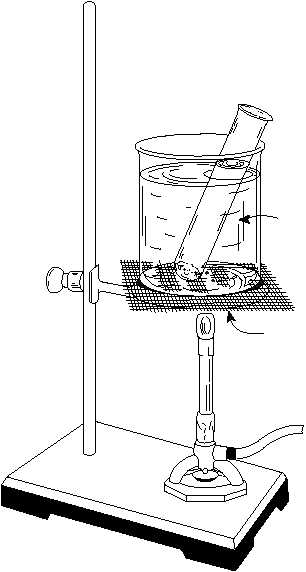28
Inorganic Qualitative Analysis (QUAL)
Heating
You should not use a burner flame to directly heat liquid in a small test-tube. Such direct
heating is too intense and too localized. It will usually cause the liquid to blow out of the
test-tube. This practice can cause injury and, in any case, ruins the experiment.
Heating is to be accomplished by resting the test-tubes
in beakers of heated water. This heating is more even
and keeps the temperature from exceeding 100 °C. If a
test-tube heating platform (also called an aluminum
holder) is available it should be used in the beaker.
Otherwise use a beaker large enough to keep the test-
tubes from protruding too far over the beaker lip.
Adjust the water level in the beaker so that only the
lower 1/2 to 3/4 of the test-tube is submerged. Move
the burner flame in and out as needed to keep the
water hot but to prevent violent boiling (see Figure D).
pH Measurement and Control
It is important in many reactions that the solution’s pH
becarefullycontrolled.Thecontrolisachievedbyadding
anacidorbasesolutiondrop-
wise until the required pH
is obtained. The pH of the
solutionshouldbemeasured
after each dropwise addi-
tion by using litmus or pH
paper. Do not dip the pH
paperintothesolution.This
practice can lead to
chemicals from the paper
getting into the solution.
The proper procedure is to
mix the solution with a
stirring rod and then to
touch the wet end of the rod
to the test paper.
The pH of a gas bubbling out of a solution can be tested by wetting the test paper with water and then holding
it over the mouth of the test-tube.
Contamination
Even the smallest contamination of your ion or reagent solutions can change the test results. Contamination is
a particular problem with these experiments because you reuse equipment so often. Clean and distilled water
rinse each piece of equipment after each use. Thus you should clean a dropper before using it in a different
solution, clean a stirring rod before using it to mix a second solution, etc.
Often cleaning requires only that the test-tube, rod, etc. be rinsed several times with tap water then 2 to 3 times
with distilled H2O. The equipment does not have to be dry. Use a test-tube brush to clean out stubborn ppts. A
dropper can be cleaned by removing the bulb and running water down the barrel.
Wire gauze
Hot water
Figure D. Heating a sample
Solution
drop
Figure E. Testing pH.


